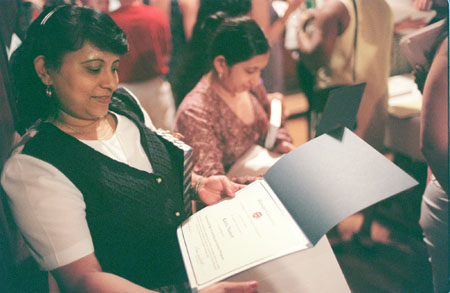Bridge to a better life
Ceremony recognizes ‘Bridge’ program students

After finishing high school in her native Greece, Marina Gerolimatos spent several years studying cosmetology near Athens, then earning a scholarship to study the profession in Paris. While her siblings left for the United States, she finished her studies in Paris and went back to Greece, near her mother, to open what became a successful beauty salon.
But in 1978, after her mother died, Gerolimatos was so grief-stricken that her doctor advised her to take a vacation. She flew to Boston to visit her siblings and has been here ever since.
Now a checker in the Eliot House dining hall, she admits that the adjustment – even after all these years – has been tough. She left behind a highly successful business, an independent lifestyle and a sense of accomplishment.
“In my country I was going ahead because I knew enough,” she says. “I had enough education and I was speaking the Greek language. I want someday to learn [English] so I feel comfortable, as if I was speaking in my home country.”
Gerolimatos came a step closer to her dream as she and her classmates from the University’s Bridge to Learning and Literacy program celebrated their successes at a June 10 recognition ceremony in the Adams House dining hall.
The Bridge program, which began in 1999, offers University employees free, on-site courses in English as a second language (ESL), literacy, General Education Development or general equivalency diploma (GED), speaking and listening, and computers. Two-hour classes are held twice a week for 16 weeks in the spring and fall, and students receive paid time off each week to attend classes.
This summer, 32 Bridge students will use their own time to participate in the Summer Reading Program, where they’ll meet weekly to discuss books.
What started two years ago as a 38-person pilot course for Faculty Club employees has extended its reach to a growing number of Harvard employees.
This year, Gerolimatos and approximately 200 other Bridge students received Academic Achievement certificates for their work. The program will be expanded to accommodate nearly 500 students next fall. Though targeted primarily at service employees (e.g. custodians, dining hall workers, security guards), the Bridge program is now open to employees from the Harvard Union of Clerical and Technical Workers (HUCTW) and other employees from outside businesses that provide contract service on the Harvard campus.
Additional literacy, ESL, and GED classes will be added to the Bridge schedule in September to accommodate new students from Unicco, Sodexho Marriott, and Restaurant Associates, says Bridge director Carol Kolenik.
According to California-based Great Place to Work Institute, this kind of workplace education is a new but growing phenomenon, especially among large employers.
“It’s not the most prevalent” practice, says Amy Lyman, co-founder of the institute. “But I do see a number of organizations taking it on because they recognize [the benefits].”
While the Bridge program runs mainly on the energy of a three-person administrative staff, seven instructors, and a number of volunteer tutors, its quick success and visible growth are also tied to the kind of support the University community has provided, Kolenik says.
For example, she says, workers who attend the classes must get support from their supervisors for the paid time off. They must also get support from co-workers who aren’t attending these courses and might have to cover for their absence.
Barbara Rice, education coordinator for the Local 26 Hotel Employees, Restaurant Employees International Union (HEREIU) education program, says Harvard’s Bridge program is unique because of its quality and accessibility. Other area employers who have tried to provide employees with similar resources have often abandoned such programs when busy seasons require a full staff, she says.
“Harvard has, to their credit, made a commitment,” she says. As a top-rated learning institution, “it is only natural that [Harvard] … can provide a first-rate program.”
For Harvard, using the classroom to enhance the workforce seems to be a perfect fit with the University’s greater mission, says Julie Stanley, senior human resources consultant in the Faculty of Arts and Sciences and a Bridge volunteer tutor.
As an ESL tutor, she’s helping one woman learn enough English so that she can help her children with their homework. As a human resources officer, she’s looking forward to helping Kolenik and others work with contract employees who could also benefit from this education.
“I’m definitely so excited that it’s growing,” Stanley says. “I think it’s terrific that it’s expanding. I don’t think people realize that there are so many people who need this help.”
Representing a number of age groups, ethnicities, and educational levels, Bridge students comprise a truly diverse group. Students speak Spanish, Portuguese, French Creole, Chinese, Tibetan, and Greek. Some students are native English speakers who never got the chance to finish basic education; others, like Gerolimatos, are educated immigrants who have not obtained high-skill jobs because of language barriers.
Kolenik says that those who have taken courses are already able to perform more efficiently in their present and are gaining the necessary skills to get better jobs.
Gerolimatos, who got her first job at the College dining hall through a family connection, has cycled through various dining halls in her 21-year career but has held similar positions at each place. When she first heard about the Bridge program, she signed up right away, in the hopes of learning the language that she believes will help her move up in her career.
She’ll continue to take classes next year, and she says she’s certain it will help her better herself. In fact, she says, it has already helped her rebuild some of the confidence she lost when she became an immigrant.
“Now I can speak without being embarrassed,” she says.
For more information about the Bridge to Learning and Literacy, call Carol Kolenik at (617) 495-2535 or e-mail carol_kolenik@harvard.edu.




